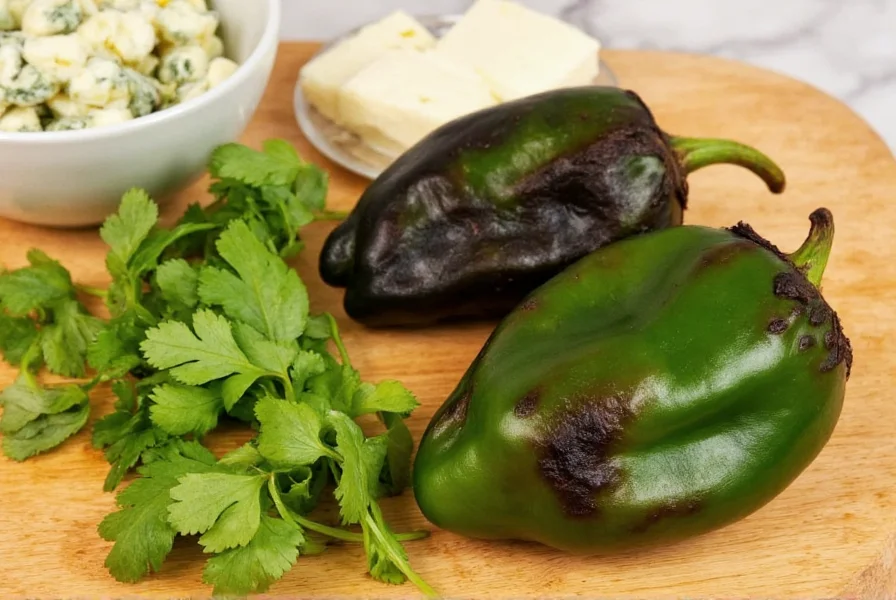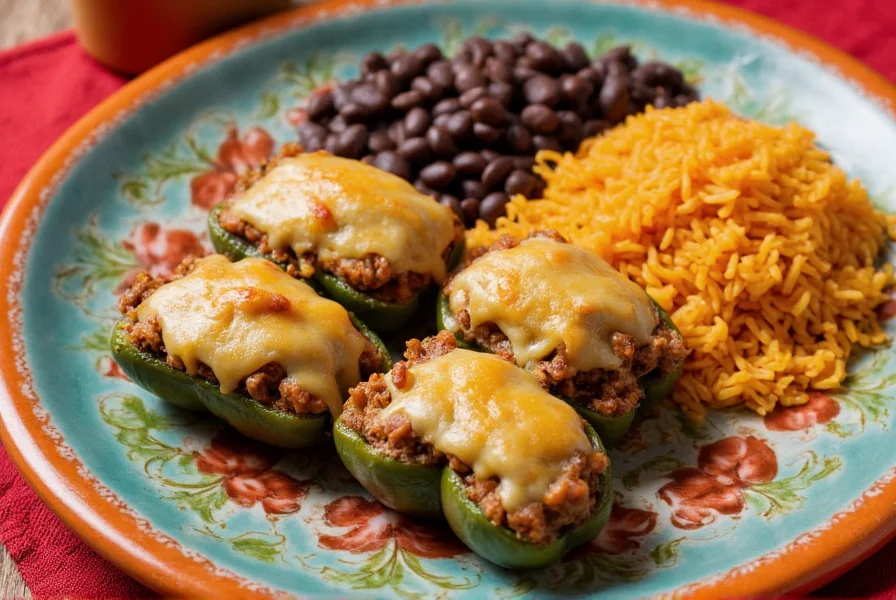The perfect poblano pepper recipe features roasted poblano peppers stuffed with cheese, coated in egg batter, and pan-fried until golden—a traditional Mexican dish known as chiles rellenos. This authentic poblano pepper recipe serves 4, requires 1 hour preparation time, and delivers mild heat (1,000-2,000 Scoville units) with rich, earthy flavor. Follow our tested method for peeling roasted poblanos without blistering your hands and achieving the ideal fluffy egg coating that stays intact during cooking.
When searching for a poblano pepper recipe, you're likely looking for that perfect balance of mild heat and rich flavor that makes these Mexican peppers so versatile. Unlike jalapeños or serranos, poblanos offer a gentle warmth that won't overwhelm your palate, making them ideal for family-friendly dishes. This authentic chiles rellenos recipe transforms simple ingredients into a restaurant-quality meal that showcases why poblanos have been cherished in Mexican cuisine for centuries.

Why Poblano Peppers Deserve a Spot in Your Kitchen
Poblano peppers (Capsicum annuum) originate from Puebla, Mexico, and have become a staple in Southwestern and Mexican cooking. These large, dark green peppers measure 2-4 inches wide and 4-6 inches long, with a distinctive heart shape. Their heat level ranges from 1,000 to 2,000 Scoville units—milder than jalapeños (2,500-8,000 SHU) but with more complexity than bell peppers (0 SHU).
When selecting poblanos, look for firm, glossy skins without wrinkles or soft spots. Fresh poblanos keep well in the refrigerator crisper drawer for up to two weeks. For longer storage, roast and freeze them in airtight containers for up to six months—a perfect solution when you find them on sale during peak season (late summer to early fall).
Classic Stuffed Poblano Peppers (Chiles Rellenos)
This authentic poblano pepper recipe serves four and features the traditional preparation method perfected in Mexican kitchens. The secret to exceptional chiles rellenos lies in properly roasting the peppers and creating a light, stable egg batter.
| Prep Time | Cook Time | Total Time | Servings | Heat Level |
|---|---|---|---|---|
| 30 minutes | 30 minutes | 1 hour | 4 | Mild (1,000-2,000 SHU) |
Ingredients
- 4 fresh poblano peppers
- 8 oz queso fresco or Monterey Jack cheese, cut into 4 sticks
- 3 large eggs, separated
- ¼ tsp salt
- 2 tbsp all-purpose flour
- 2 tbsp vegetable oil
- 1 cup tomato salsa (for serving)
- Fresh cilantro (for garnish)
Step-by-Step Preparation
- Roast the poblanos: Place peppers directly over gas flame or under broiler, turning frequently until skin is evenly charred (about 8-10 minutes). Transfer to a bowl and cover with plastic wrap for 10 minutes to steam.
- Peel carefully: Using your fingers (not a knife), gently rub off the charred skin under cool running water. Make a small slit along one side of each pepper and carefully remove seeds while keeping the pepper intact.
- Prepare the egg batter: Beat egg whites with salt until stiff peaks form. Gently fold in beaten yolks and flour until just combined—do not overmix.
- Stuff and coat: Place cheese sticks inside each pepper. Dip stuffed peppers into egg batter, ensuring complete coverage.
- Fry to perfection: Heat oil in skillet over medium heat. Fry coated peppers for 3-4 minutes per side until golden brown. Drain on paper towels.
- Serve immediately: Plate with warm tomato salsa and fresh cilantro. Traditional accompaniments include Mexican rice and refried beans.
Pro Tips for Perfect Poblano Pepper Recipes
Mastering poblano pepper preparation requires understanding their unique characteristics. Here are professional techniques for consistently excellent results:
- Peeling without tears: The steam method after roasting loosens the skin without damaging the tender pepper flesh. Never use a knife—it makes the peppers too fragile for stuffing.
- Heat control: If you prefer milder flavor, remove all white ribs and seeds. For more heat, leave some seeds intact.
- Egg batter stability: Room temperature eggs create a more stable foam. Adding a pinch of cream of tartar to egg whites helps maintain volume.
- Frying temperature: Maintain oil at 350°F (175°C)—too hot burns the batter, too cool makes it greasy.
Delicious Poblano Pepper Variations
Once you've mastered the basic technique, experiment with these popular poblano pepper recipe variations:
- Vegetarian delight: Mix black beans, corn, and diced tomatoes with the cheese filling for a hearty meatless option.
- Breakfast rellenos: Stuff with scrambled eggs and chorizo for a savory morning meal.
- Creamy poblano soup: Blend roasted poblanos with chicken broth, onions, and cream for a silky soup (perfect use for extra roasted peppers).
- Poblano cornbread: Add diced roasted poblanos to your favorite cornbread recipe for Southwestern flair.
Common Substitutions and Solutions
Can't find fresh poblanos? Here's how to adapt your recipe:
- Substitute options: Anaheims work well as a direct replacement (slightly milder). For more heat, use a mix of bell peppers and jalapeños (1 part jalapeño to 3 parts bell pepper).
- Dried alternative: Ancho chiles (dried poblanos) work in sauces and stews but won't substitute for fresh in stuffed pepper recipes.
- Vegetarian cheese note: Traditional queso fresco uses animal rennet—look for "vegetarian" labeling if needed.
Food Safety and Storage Guidelines
Proper handling ensures your poblano pepper recipes remain safe and delicious:
- Always wear gloves when handling hot peppers and avoid touching your face
- Store fresh poblanos in the refrigerator crisper drawer for up to 2 weeks
- Roasted and peeled poblanos freeze well for up to 6 months in airtight containers
- Cooked stuffed poblanos keep refrigerated for 3-4 days—reheat in oven to maintain texture
- Never store cut peppers at room temperature for more than 2 hours

Frequently Asked Questions
How do you remove the skin from poblano peppers without making them soggy?
The steam method is crucial for perfect peeling. After charring the skin over flame, place peppers in a covered bowl for 10 minutes—this creates steam that loosens the skin. Then gently rub under cool running water with your fingers (not a knife). This preserves the pepper's structure while removing skin completely without waterlogging.
Why does my egg batter slide off the peppers when frying?
This happens when the egg whites aren't properly whipped or the peppers are too wet. Ensure egg whites form stiff peaks before folding in yolks, and thoroughly dry peppers after peeling (pat with paper towels). The batter should coat like a light foam, not a runny liquid. Frying oil should be hot enough (350°F/175°C) to immediately set the batter upon contact.
Can I make stuffed poblano peppers ahead of time?
Yes, but with specific timing. Roast and stuff peppers up to 24 hours ahead, storing covered in the refrigerator. However, wait to coat with egg batter and fry until just before serving—this ensures the light, fluffy texture. For events, prepare components separately and assemble/fry immediately before serving for best results.
Are poblano peppers healthy?
Yes, poblanos are nutrient-dense. One medium poblano provides 150% of your daily vitamin C, plus significant vitamin B6, vitamin K, and dietary fiber. They contain capsaicin (in lower amounts than hotter peppers), which may boost metabolism and reduce inflammation. The roasting process preserves most nutrients while enhancing antioxidant availability.
What's the difference between poblano and pasilla peppers?
Poblanos are fresh, dark green peppers with mild heat. When dried, they become ancho chiles. Pasilla peppers are actually dried chilaca peppers (a different variety), not dried poblanos. Fresh poblanos are heart-shaped and larger than fresh chilacas (which become pasillas when dried). Don't substitute dried ancho for pasilla—they have distinct flavor profiles.










 浙公网安备
33010002000092号
浙公网安备
33010002000092号 浙B2-20120091-4
浙B2-20120091-4